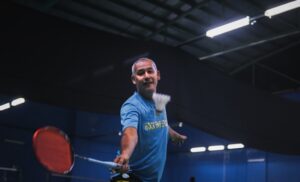Key Shots in Table Tennis
Hello, my name is Malik Atif. In this blog, I’m going to give an overview of the key shots we use in table tennis. I’m going to give some information about what the shots are called, when we should use the shots, and I’ll also give a bit of information about how to execute the shots. If you are a beginner player, um you’re just getting into table tennis. Maybe you play a little socially, um, but you’re not too sure of what all the shots we use in table tennis. Why we use them. Well, this is the perfect video for you. Right then, let’s take a look at our first shot.
Drives: Forehand Drive and Backhand Drive
We’re going to start with drives: forehand drive and backhand drive. Elsewhere, you may hear this called a counter hit, but for the purpose of this video, I’m going to call it a drive. Now, what is a drive? It is an attacking shot where you hit through the ball, adding just a bit of topspin, sending it over to your opponent, hopefully with a bit of speed, a bit of spin to put them under pressure.
How do we do a drive? Well, to do a drive, we play forwards and up, hitting through the ball, and that upwards motion just starts to generate a bit of topspin. Once you’ve learned how to drive the ball consistently, it is then really easy to develop a stronger topspin shot. But for a beginner, learning to drive is a little easier to do. It’s, um, pretty much effective straight away. You can start winning points by driving, and it allows you to progress to more advanced topspin in the future.

Pushes: Backhand Push and Forehand Push
Next on our list, we have pushes: backhand push and forehand push. This is more of a defensive shot where we put backspin on the ball to make it difficult for our opponents to attack. And we would typically use pushes when our opponent has given us a backspin serve. We can return the backspin serve with a push, forehand push, or backhand push. Or if we get engaged in a more defensive rally and our opponent is pushing or chopping, we can return all of their defensive backspin shots with a push.
Okay, the technique here is you now need to contact underneath the ball. Your bat comes from a higher position to a lower position, and you’re trying to brush the ball to generate some backspin.
Topspin VS Backspin
Next, we have topspin versus backspin: forehand topspin versus backspin, and backhand topspin versus backspin. Elsewhere, you may hear this called open-ups or loops. We’re all referring to the same thing: playing a topspin stroke against a backspin ball.
So when should we use this stroke? Well, when we have backspin. So in the previous shot, when we were talking about pushes, when we were putting backspin on the ball. Well, one way of overcoming these shots is to play topspin against backspin. Now, at its simplest, what we’re trying to do here is swing a little more vertically, lifting the ball up, contacting up the back of the ball to counter the backspin. That makes the ball go up, clear the net, and the spin brings the ball back down on the other side.
Blocks: Forehand Block and Backhand Block
Next, we have blocks: forehand block and backhand block. Blocks are more defensive shots which we can use to return our opponent’s topspin attacks.
Okay, just very quickly on the technique: blocks require much shorter strokes, um, soft hands, just kind of stopping the ball, using the pace of the ball to return it. So it’s a much more, um, softer shot that you’re going to play. Blocking is another crucial shot, which for beginner players, if you can learn to block, then that gives you a way of returning your opponent’s attacks. And not only return the attacks, but you can return them in quite an effective way. Because when you block the topspin, um, the ball tends to go back quite quick because the topspin attack has lots of speed and lots of energy. So you just kind of stop the ball, stop the ball, block it, block it, and it goes back quite quick. And it can really put your opponent under pressure.
Flicks: Forehand Flick and Backhand Flick
So a flick is an attacking shot which we play over the table. Um, we would use it if our opponent serves short on the backhand side. We’re looking just to start with our elbow a little higher, getting our bat pointed a little more down, and we’re going to use our wrist to lift the ball over the net. If it’s a backspin serve, we’re going to flick that ball over. Okay, just trying to contact up the back of the ball.
On the forehand side, we’re going to come in with quite an open bat angle, and we’re going to kind of try to hit through the back of the ball. It’s a slightly flatter contact on the forehand side. Um, can be a tricky shot, the forehand flick, um, but very effective if you can pull it off.
Chops: Forehand Chop and Backhand Chop
Next, we have chops. This could be a forehand chop or a backhand chop. This is a defensive shot, typically played further away from the table, which you can use to return your opponent’s attacks. These could be their drive attacks or their topspin attacks. You can use chops to send the ball back with lots of backspin, making it difficult for your opponent to attack again.
Now, to do chops, it’s a bigger motion, plenty of acceleration, trying to contact underneath the ball. It’s this chopping motion. Okay, and if you get the contact right, where you brush the ball, then you generate lots and lots of backspin. And then that makes it very difficult for your opponent to keep their attacking shots going. Same thing on the backhand side, lots of acceleration going from a higher position to a lower position, brushing underneath the ball.
Lobs: Forehand Lob and Backhand Lob
Next, we’re going to look at lobs: forehand lob and backhand lob. This is another defensive shot which you would play further away from the table. Um, and you can use lobs to return your opponent’s attacks. Unlike chops, where you’re trying to keep the ball low over the net, with lobs, you’re trying to send the ball really high. And this can be quite problematic for some players who find it difficult to deal with high balls.
How do we do a lob? Well, lobs are, at their most basic, where you can kind of just hit underneath the ball, and that just lifts it up nice and high. You can also do lobs which have a little more topspin, where you are brushing the ball. You still send it high, but when it kicks on the other side of the table, it’s going to jump towards your opponent. And that makes it even more difficult for them to deal with those shots.
Smashes: Forehand Smash
And finally, we’re going to look at the forehand smash. Now, this is a shot we can play to return those high lobs we were just talking about. So your opponent has sent a high ball; you want to attack it. You can use a forehand smash.
Now, the Key Shots in Table Tennis to a forehand smash for me is to contact the ball around shoulder height. That’s a good height. Get your body a little more sideways on, and then hit through the ball. Okay, drive through the ball. We don’t really need to add that much spin to this shot; we can just hit through the back of the ball.
Conclusion
A lot of information I’ve given you there. I’ve kind of given eight types of key shots: drives, pushes, topspin versus backspin, blocks, flicks, chops, lobs, and smashes. Right. There’s a lot of information to digest there, but to be honest with you, if you can develop this range of shots, you’ve pretty much got the majority of shots you’re going to need. When playing table tennis and to progress to an advanced level, there are other shots which people use. Um, but focus on these core ones first, and then you can develop other ones later.
FAQ’s
1. What are the basic shots in table tennis?
The basic shots include:
- Drives: Forehand and Backhand
- Pushes: Forehand and Backhand
- Top Spin vs. Backspin
- Blocks: Forehand and Backhand
- Flicks: Forehand and Backhand
- Chops: Forehand and Backhand
- Lobs: Forehand and Backhand
- Smashes: Forehand Smash
2. What is the difference between a drive and a push?
A drive is an attacking shot that applies slight topspin and speed, while a push is a defensive shot that uses backspin to counter your opponent’s attacks.
3. When should I use a block in table tennis?
Blocks are used to return your opponent’s topspin shots defensively by absorbing their pace and redirecting the ball quickly.
4. What is the purpose of a chop?
Chops are defensive shots used to return strong attacks with heavy backspin, making it challenging for the opponent to continue their offensive plays.
5. How do I execute a lob?
Lobs are executed by hitting the ball high and deep, often with topspin, to put your opponent under pressure or to buy time to recover your position.
Differences Between Key Shots in Table Tennis
| Shot Type | Purpose | Spin Used | Position Played | Key Technique |
|---|---|---|---|---|
| Drive | Attacking | Light topspin | Close to the table | Forward and upward motion through the ball |
| Push | Defensive | Backspin | Close to the table | Brush under the ball with a downward motion |
| Top Spin vs. Backspin | Attacking against backspin | Topspin | Close to or mid-distance | Swing vertically to lift and counter backspin |
| Block | Defensive | Opponent’s topspin | Close to the table | Short stroke with soft hands |
| Flick | Attacking over the table | Light topspin | Over the table | Use wrist and elbow for precise lift |
| Chop | Defensive | Heavy backspin | Mid-to-long distance | Brush under the ball with a chopping motion |
| Lob | Defensive | Light topspin or none | Long distance | Hit under the ball to lift it high |
| Smash | Attacking against high lobs | None or light topspin | Shoulder height, close to mid-table | Hit through the ball with power |




